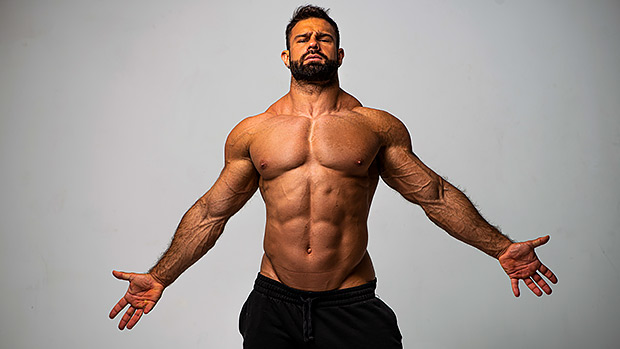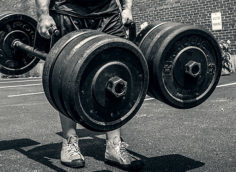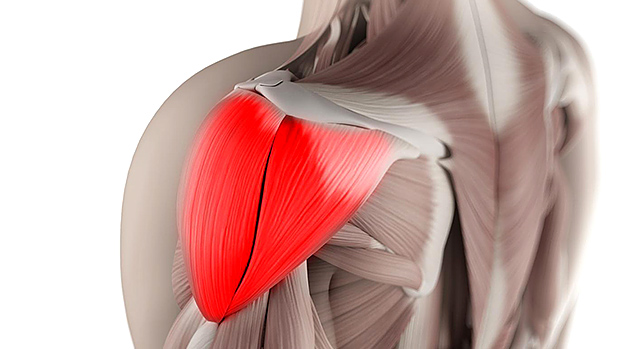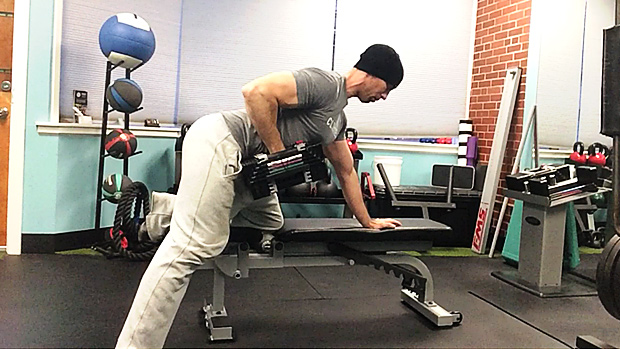For lifters, the most common injuries arise from poor movement at two key junctions of the body.
- For the upper body, it's poor scapular movement while pressing and pulling.
- For the lower body, it's poor hip flexion and extension patterns.
But if you can fix these issues in your lifts, you won't just stop the pain; you'll be able to lift more weight, more consistently. That means more gains.
So let's dig into the two most common mistakes and go over a few exercises that'll help you do better.
You probably don't think about "scapular movements" very often, but now's the time to start. These are movements initiated by the shoulder blades, and having good shoulder health hinges on their proper movement.
Here's how your shoulder blades should be able to move:
Most lifters screw up the row, which should finish with end-range scapular movement. It's NOT about how far your elbow can be drawn behind your back. Drawing your elbows back as far as they can go pulls tension away from your lats and drives the head of your humerus forward from the socket into the rotator cuff tendons and long head biceps tendon.
If you do this often, you'll notice chronic anterior shoulder pain as one or more of these tendons get inflamed. Work through this pain long enough and bye-bye heavy presses.
Likewise, powerlifting coaches often teach competitive lifters to pin their shoulder blades without any movement on bench press 1RM attempts. But that doesn't mean this has any training benefits for those seeking to gain muscle and get stronger.
Lying on a bench also restricts your ability to fully protract your scapula through the positive. Instead of focusing on protracting, don't pin your scapula. Allow some freedom to move without exaggeration. Then actively retract your scapula with each negative. This can alleviate existing pain while pressing.
Vertical pressing allows for better freedom of the shoulder blades. For barbell, dumbbell, or landmine versions, your scapula can and should upwardly rotate through the positive portion of the press and retract and depress through the negative.
Vertical pulling, like chin-ups and pulldowns, also allows for free scapular movement. Focus on elevating (upwardly rotating) the scapula at the bottom of chin-ups and the fully extended position of pulldowns. Then pull your scapula downward in tandem with your elbows while pulling your body up/pulling the cables down.
Every row variation should allow freedom of movement of your shoulder blades. With bent-over row variations, be careful not to collapse into so much thoracic flexion that it rounds your upper back and puts stress on your lower back. The thoracic spine should be mobile, but we want to maintain a stable lumbar position under load.
Having good scapular control is like opening a door without issue. Poor scapular control means applying brute force to a sticky door. Push or pull hard enough on a stuck door, and eventually, you damage the hinges.
Good scapular mobility, along with strong middle traps and rhomboids, helps keep your shoulders healthy. Neglecting rhomboids and middle trap training also leaves your upper back weak for heavy compounds like squats, deadlifts, and bent-over rows. You also miss out on upper-back thickness.
Here are three exercises to help you improve motor control of your shoulder blades:
1. Face-Pull with Overhead Press
Starting with a semi-supinated (thumbs up) grip, focus on driving your elbows back in a horizontal path. Keeping tension in the upper back/trap area, push up and outward into an overhead position. Keep your neck neutral throughout. Follow the same movement in reverse to restart.
A face-pull should always involve protraction and retraction of your shoulder blades. The added overhead press adds an upward rotation component while keeping your scapular retractor muscles under tension.
2. Cable Reverse Flye
Most bodybuilders want better rear delts. Cable reverse flyes serve double duty for rear-delt training and healthy scapular movement.
Stand between cable towers with their attachments roughly at or above shoulder height and grasp the opposite side's cable in each hand.
Begin with your hands together or crossed over. Start with your shoulder blades protracted (away from each other). Retract (draw together) your shoulder blades as you sweep your hands away from the midline of your body to the end of your shoulder range of motion. Then allow your shoulder blades to glide forward to their starting position as you draw your hands together.
You can do reverse flyes with straight or slightly bent elbows; just maintain your elbow angle through the entire range. Resist the temptation to flex and extend at your elbows, which shifts work to your triceps. The scapular movement forces your mid traps and rhomboids to work in conjunction with your rear delts, promoting healthy shoulder movement.
3. Dumbbell Arnold Press
Hold dumbbells in front of your chest with palms facing you. Begin with your shoulder blades drawn back and down. As you press the dumbbells overhead, allow your shoulder blades to upwardly rotate. They should move freely as they follow the path of your pressing motion.
The dumbbells should rotate a full 180-degrees until your palms face away from you at the top. Reverse rotation and pull your shoulder blades down and back as you lower the weight to the starting position.
You can do Arnold presses seated or standing, both arms at the same time or alternating.
The words "hip flexion and extension" might not run through your mind when you're about to deadlift or squat. That's the language of personal trainers. But it'd be worth it to start thinking like one because, in essence, you're your own lifelong personal trainer.
A lot of knee and back issues originate from one simple thing: weak glutes and poor hip movement. Okay, that's two simple things, but they're associated.
Lifters with poor hip motor control or limited hip mobility often force movement into ranges of motion the hips can't accommodate. It causes stress up the chain (lower back) or downstream (knees). Do this often enough and under significant load, and both scenarios are time bombs for pain.
We see a lot of nonsense language about the glutes not firing. Your glutes always work during any hip extension pattern. They may be weak through poor movement and too much sitting. You may also not be putting them in a position to work effectively. This often coincides with excessive movement through your lumbar spine. Picture the deadlifters who pull with shitting-dog posture.
To restore good hip movement, we need to minimize lumbar flexion/extension. Start by learning to keep your lower back flat. Keep shoulder blades retracted and upper back flat when loading squats and deadlifts. A collapsed and rounded upper back places more pressure on your lower back. Bracing your abs also helps keep your lumbar spine neutral.
Here are three exercises to strengthen glutes and improve your hip motor pattern:
1. Stiff-Leg Deadlift
Stiff-leg deadlifts (or Romanian deadlifts) teach and strengthen a basic hip hinge pattern. Not only do these load glutes and hamstrings to strengthen and grow them, but it also teaches and reinforces a safer way to bend over and pick stuff up.
Untrained people tend to round their back while picking up heavy things, increasing the chance of a debilitating back injury. By using your hips instead of your lower back, you reduce the risk of injury.
Start from a standing position with shoulder blades set back, chest out, and knees slightly bent to upwards of 20 degrees. Though your torso pivots forward, focus instead on pushing your hips back as you descend. The goal isn't to lower the bar to the ground but instead to maximize hip range of motion while maintaining a flat spine.
When you've reached maximum stretch of your glutes and hamstrings at the bottom, reverse direction by thrusting the hips forward into hip (not lumbar) lockout. Straighten your knees at the top of the motion.
Initiate the next negative by slightly bending the knees as you hinge at your hips. The slight knee bend allows for both greater mobility at the hips and shifts tension and emphasis more to the glutes and away from your hamstrings.
2. Cable Glute Pull-Through
Cable pull-throughs replicate the hip hinge pattern of the stiff-leg deadlift with a different force vector acting against your movement. The resistance is horizontal instead of vertical, transferring peak tension to the lockout position.
Cable pull-throughs have limits to their potential loading before the weight will pull you off balance, leaving them less than ideal for maximum glute hypertrophy, but we're more focused here on healthy hip movement patterns, where pull-throughs function as a great teacher.
Start with a slight knee bend to shift tension to your glutes. Maintain a neutral lower back, though you're able to crunch your thoracic spine forward a little to emphasize glute recruitment and prevent your lumbar spine from extending at lockout.
Pivot your torso forward and hips back to load and stretch your glutes. Thrust the hips forcefully out of the deepest stretch into hip lockout. Straighten your knees as you lockout. Because the cable will pull against your center of gravity, you'll need to lean forward while keeping your weight in your heels.
3. Single-Leg Glute Bridge
Lay on your back and pull one heel close to your glutes. Elevate and extend the other leg.
Initiate the movement by pushing your planted heel into the floor as your hips and back rise while your shoulders remain grounded. Focus on pushing your working hip toward the ceiling as you lockout at your hip. Finish all reps on one leg before switching to the other side.
All of these exercises can be programmed as standalone during regular workouts. Stiff-leg deadlifts work well as a progressive strength exercise, while the rest serve better as accessories or mobility drills.
Each can be combined as supersets without increasing training time or much overall fatigue to your workout. Think of them as ways to enhance your movement quality and joint health, not as more ways to brutalize your system.





